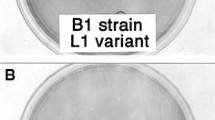Summary and Conclusions
Treatment of type 1 reovirus with proflavine resulted in the loss of hemagglutinating activity of this virus and also its cytopathogenicity, depending on the concentration of proflavine used, was either significantly reduced or completely inhibited. Further, various tissue cultures inoculated with proflavine treated virus became resistant to reinfection with both related and unrelated viruses. This interfering activity of proflavine treated virus was found to depend on the concentration of proflavine used. Optimum interference was obtained when tissue cultures were preinoculated with reovirus treated with proflavine in the concentration between 100 to 300 μg per ml. Increase in proflavine concentration above this optimal range was followed by decrease in the interfering activity.
It may be assumed that treatment of reovirus with higher concentration of proflavine results in inactivation of the virus. The assumption that interfering activity depends on the viability of the virus is supported by the results with heat inactivation when it was shown that exposure of the proflavine treated virus to 56° C completely abolished the interfering effect of so treated virus. Further, this interference phenomenon apparently is due to the intracellular position of the treated virus since exposure of preinoculated cultures to homologous antiserum did not change their resistance to the challenge viruses nor altered their adsorbing capacity.
The experiments which are in progress now indicate that the changes in the behaviour of treated virus are not due to the presence of proflavine as such but rather the mutagenic effect of proflavine on the virus.
Similar content being viewed by others
References
Fitzgerald, R. J.: Bacterial viruses II. Action of Acridines in inhibiting lysis of virus infected bacteria. J. Imnmnol.52, 127 (1946).
Foster, R. A. C.: An analysis of the action of proflavine on bacteriophage growth. J. Bact.56, 795 (1948).
De Mars, R. I.: The production of phage related materials when bacteriophage development is interrupted by proflavine. Virology1, 83 (1955).
Thompson, R. L.: The effects of metabolites and enzyme inhibition on the growth of vaccinia virus. J. Immunol.55, 345 (1947).
Ledinko, N.: Production of noninfectious complement fixing poliovirus particles in the HeLa cells, treated with proflavine. Virology6, 512 (1958).
E. Zalan, J. Lesiak, andN. A. Labzoffsky: The effect of proflavine on the hemagglutinating activity of Reo and ECHO viruses. Canad. J. Microbiol8, 181 (1962).
Dulbecco, R., andM. Vogt: Plaque formation and isolation of pure lines with poliomyelitis viruses. J. exp. Med.99, 167 (1954).
Author information
Authors and Affiliations
Rights and permissions
About this article
Cite this article
Zalan, E., Labzoffsky, N.A. Interference between proflavine treated reovirus and related and unrelated viruses. Archiv f Virusforschung 15, 200–209 (1965). https://doi.org/10.1007/BF01257731
Received:
Issue Date:
DOI: https://doi.org/10.1007/BF01257731



